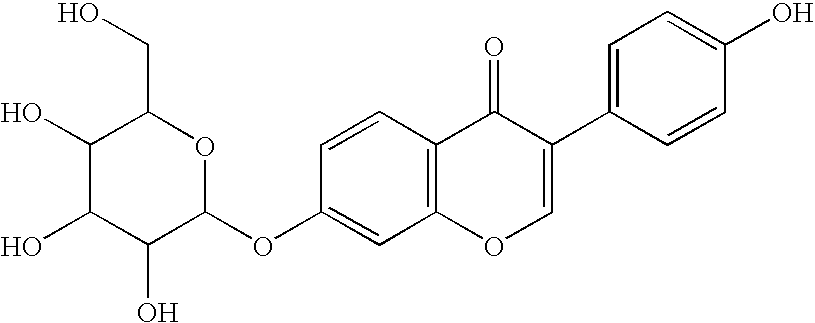ALDH-2 inhibitors in the treatment of addiction
a technology of aldh-2 inhibitors and addiction, applied in the direction of biocide, drug compositions, group 5/15 element organic compounds, etc., can solve the problems of fetal alcohol syndrome, major health problems worldwide, incurable conditions, etc., and achieve the effect of reducing the number of bar presses
- Summary
- Abstract
- Description
- Claims
- Application Information
AI Technical Summary
Benefits of technology
Problems solved by technology
Method used
Image
Examples
example 1
Preparation of a Compound of Formula R1WX
A. Preparation of a Compound of Formula (4) in which R is Phenyl
[0415]
[0416]A 50 mL round bottomed flask equipped with a condenser was charged with benzamide (a compound of formula (b), 363.4 mg, 3.0 mmol) and 1,3-dichloroacetone (457.1 mg, 3.6 mmol, 1.2 equiv.). This mixture was heated at 130° C. for 1 hour under a nitrogen atmosphere. After cooling to room temperature, the resulting mixture was purified by recrystallization from acetonitrile (6 mL). The suspension was heated under reflux reaction condition for 5 minutes and cooled down to ambient temperature. The resulting solid was filtered through a glass filter, and the crystals on the filter were washed with acetonitrile (2 mL). The desired product, 4-(chloromethyl)-2-phenyl-1,3-oxazole, was obtained as a colorless powder.
B. Preparation of Other Compounds of Formula (4) in which R is Phenyl
[0417]Similarly, following the procedures of Example 1A, substituting other compounds of formula (...
example 2
Preparation of a Compound of Formula (5)
[0438]
Step 1—Preparation of a Compound of Formula (9)
[0439]A mixture of 1-(2-hydroxy-4-methoxyphenyl)ethane-1-one (20 g, 120 mmol) and N,N-dimethylformamide dimethylacetal (23 g, 181 mmol) was stirred at 90° C. for 2 hours. After cooling to room temperature the reaction mixture provided a yellow precipitate, which was washed with ethyl acetate (3×30 ml), water (2×50 ml), and dried under reduced pressure to yield 3-(dimethylamino)-1-(2-hydroxy-4-methoxyphenyl)prop-2-en-1-one (9) as the trans isomer; MS 222.1 (M+H)
Step 2—Preparation of a Compound of Formula (5)
[0440]To a solution of 3-(dimethylamino)-1-(2-hydroxy-4-methoxyphenyl)prop-2-en-1-one (20.0 g, 90.37 mmol) in anhydrous chloroform (100 ml) at 0° C. was added N-iodosuccinimide (23.5 g, 99.22 mmol) and silica gel (40 g). The reaction mixture was stirred at 0° C. for 60 minutes, then the insoluble material filtered off. The filtrate was washed with aqueous sodium thiosulfate (0.5M, 2×50 ml)...
example 3
Preparation of a Compound of Formula I
Step 1. Preparation of a Compound of Formula (6) in which R1 is 4-Methyl-2-[4-(trifluoromethyl)phenyl](1,3-thiazol-5-yl), and W is Methylene
[0442]
[0443]A mixture of 7-hydroxy-3-iodochromen-4-one (864 mg, 3.0 mmol), 5-(chloromethyl)-4-methyl-2-(4-(trifluoromethyl)phenyl)thiazole) (875 mg, 3.0 mmol), sodium iodide (450 mg, 3.0 mmol), and potassium carbonate (552 mg, 4.0 mmol) was dissolved in N,N-dimethylformamide (10 ml) at room temperature under nitrogen. The mixture was heated at 600 for 1 hour, cooled to room temperature, and water (30 ml) added to the mixture. The aqueous mixture was extracted with methylene chloride (3×30 ml), and the combined organic layer washed with brine (30 ml), dried over sodium sulfate, and solvent removed from the filtrate under reduced pressure. Crystallization of the crude product from ethyl acetate (4 ml) gave 3-iodo-7-({4-methyl-2-[4-(trifluoromethyl)phenyl](1,3-thiazol-5-yl)}methoxy)chromen-4-one, a compound of ...
PUM
| Property | Measurement | Unit |
|---|---|---|
| temperature | aaaaa | aaaaa |
| temperature | aaaaa | aaaaa |
| temperature | aaaaa | aaaaa |
Abstract
Description
Claims
Application Information
 Login to View More
Login to View More - R&D
- Intellectual Property
- Life Sciences
- Materials
- Tech Scout
- Unparalleled Data Quality
- Higher Quality Content
- 60% Fewer Hallucinations
Browse by: Latest US Patents, China's latest patents, Technical Efficacy Thesaurus, Application Domain, Technology Topic, Popular Technical Reports.
© 2025 PatSnap. All rights reserved.Legal|Privacy policy|Modern Slavery Act Transparency Statement|Sitemap|About US| Contact US: help@patsnap.com



